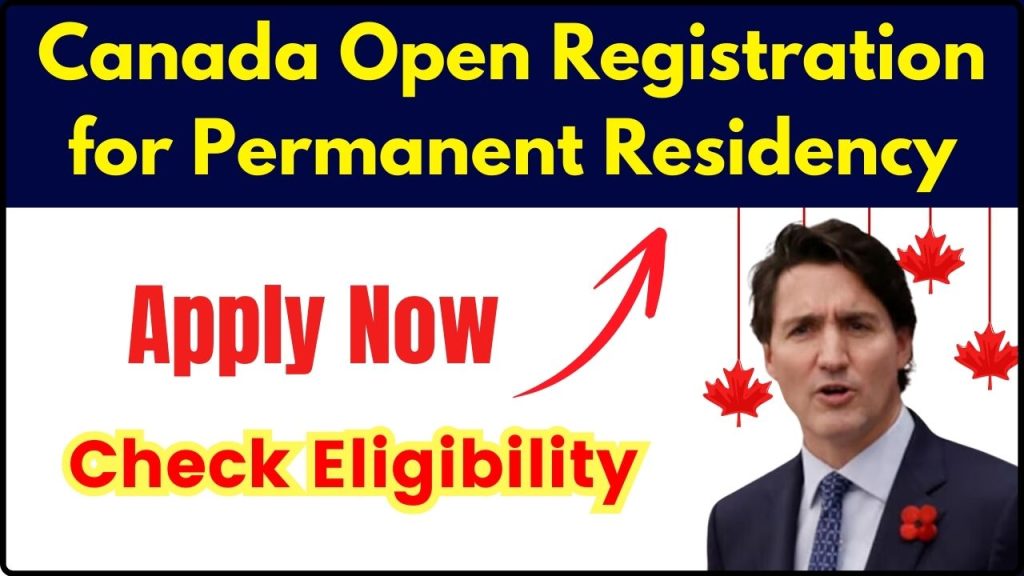Canada Open Registration for Permanent Residency: If you’re considering moving to Canada, applying for permanent residency (PR) is a major step toward building a new life in one of the world’s most welcoming and diverse countries. This guide provides an in-depth look at how to apply for permanent residency in Canada in 2024, covering eligibility, application steps, important requirements, and practical tips to help you navigate the process smoothly.

Canada Open Registration for Permanent Residency
| Key Highlights | |
|---|---|
| Primary Program | Canada Express Entry for Permanent Residency |
| Other PR Pathways | Provincial Nominee Program, Family Sponsorship, Atlantic Immigration Program |
| Eligibility | Based on work experience, language skills, education, age, etc. |
| Cost Overview | Application fees, biometric fees, language tests, and educational assessments |
| Processing Time | Typically 6 months for Express Entry, may vary based on program and profile |
| Resources | IRCC Website |
Applying for permanent residency in Canada is a structured process, and following each step carefully can improve your chances of success. With several pathways to PR, it’s essential to choose the right one based on your profile, prepare all documents, and understand the residency requirements and costs involved. The journey may be complex, but Canada offers ample opportunities for a rewarding life, making it well worth the effort.
Why Choose Canada for Permanent Residency?
With its high quality of life, excellent healthcare, safe communities, and diverse culture, Canada has become a top destination for immigrants worldwide. Permanent residency in Canada offers several benefits, including:
- Freedom to Work: PR holders can work for any employer across Canada.
- Access to Healthcare and Social Benefits: PR holders enjoy access to Canada’s public healthcare system and social benefits.
- Pathway to Citizenship: After a few years as a PR, you may qualify for Canadian citizenship, which opens doors to voting and other rights.
- Educational Benefits: Children of PR holders can attend public primary and secondary schools free of charge and have reduced tuition fees at Canadian universities.
Overview of PR Pathways in Canada
Canada offers several pathways for obtaining PR, with the Express Entry system being the most popular for skilled workers. Here’s a look at the primary PR pathways:
- Express Entry: A points-based system that includes three programs:
- Federal Skilled Worker Program (FSWP)
- Federal Skilled Trades Program (FSTP)
- Canadian Experience Class (CEC)
- Provincial Nominee Program (PNP): Each Canadian province and territory has its immigration programs that allow them to nominate individuals for PR based on local labour market needs.
- Family Sponsorship: Canadian citizens and PR holders can sponsor close family members to immigrate to Canada.
- Atlantic Immigration Program: This program is for skilled workers and international graduates who want to live in one of the Atlantic provinces: New Brunswick, Nova Scotia, Prince Edward Island, or Newfoundland and Labrador.
Guide to Apply for Permanent Residency through Express Entry
Step 1: Check Your Eligibility
The first step is to determine your eligibility. Use the Come to Canada tool from the IRCC website, which will ask you questions about your background, education, and work experience to assess which program(s) under Express Entry may be suitable for you.
Step 2: Gather Necessary Documents
Once you confirm your eligibility, begin collecting the required documents. Here’s what you’ll typically need:
- Language Test Results: For English, you may need to take either the IELTS or CELPIP. For French, TEF or TCF tests are accepted.
- Educational Credential Assessment (ECA): If you studied outside of Canada, you need an ECA from an approved organization, like WES, to verify that your education meets Canadian standards.
- Proof of Work Experience: Employment letters and payslips may be required to validate your job history and roles.
- Identification and Travel Documents: Such as a valid passport.
Step 3: Create an Express Entry Profile
Once you have all the necessary documents, create an Express Entry profile on the IRCC website. Here, you will receive a Comprehensive Ranking System (CRS) score, which is based on factors such as age, education, work experience, and language skills.
Step 4: Improve Your CRS Score
To enhance your chances, consider improving your CRS score by:
- Retaking language tests for higher scores.
- Gaining more work experience, especially within Canada.
- Pursuing additional educational qualifications.
- Including your spouse’s qualifications if they will accompany you.
Step 5: Receive an Invitation to Apply (ITA)
If your CRS score meets or exceeds the minimum required in an Express Entry draw, you will receive an Invitation to Apply (ITA). At this point, you’ll have 60 days to complete your PR application.
Step 6: Submit Your Application for PR
Submit your full PR application via the online portal, including all required documents and fees. Ensure accuracy, as mistakes can cause delays or rejections.
Step 7: Wait for Processing
Processing times typically range from six months for Express Entry applications, although times may vary based on your individual profile and background checks.
Step 8: Receive Confirmation of Permanent Residence (COPR)
Upon approval, you will receive a Confirmation of Permanent Residence (COPR). You’ll need this document when landing in Canada to confirm your PR status.
Costs of Applying for Permanent Residency
Here’s a breakdown of costs associated with a PR application:
- Application Fee: CAD 850 per adult.
- Right of Permanent Residence Fee: CAD 515 per adult.
- Biometric Fees: CAD 85 per person.
- Language Tests: Fees vary by test provider; IELTS costs about CAD 300.
- Educational Credential Assessment: Around CAD 200, depending on the agency.
$648.91 Canada Child Benefit Tax In November 2024: Check Eligibility to claim it, Payment Date
Canada $1546 OAS Direct Deposit Coming in November 2024: Who will get this? Check Eligibility
Life as a Permanent Resident in Canada
Once you become a PR, you’ll enjoy several rights, such as the ability to live and work anywhere in Canada, access to healthcare, and public school benefits for your children. However, PR holders must meet certain residency requirements—living in Canada for at least 730 days within a five-year period to maintain their status.
Common Mistakes to Avoid
- Incomplete or Incorrect Information: Double-check all information to avoid delays or rejections.
- Not Preparing for Language Tests: Practice thoroughly, as test scores are a major component of your CRS score.
- Delaying Submission of ITA: Remember, you only have 60 days to submit a complete PR application after receiving an ITA.
FAQs On Canada Open Registration for Permanent Residency
1. Can I apply for PR if I don’t have a job offer?
Yes, having a job offer is not a requirement for Express Entry, although it can increase your CRS score.
2. What is the processing time for PR applications?
Express Entry applications are typically processed within six months, but times can vary.
3. How long do I need to stay in Canada to maintain my PR status?
You must live in Canada for at least 730 days in a five-year period.
4. Are family members included in my application?
Yes, you can include your spouse and dependent children in your PR application.

